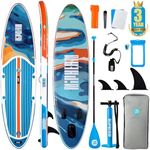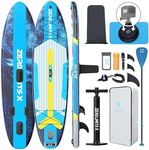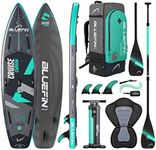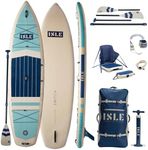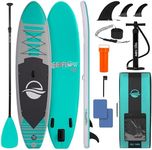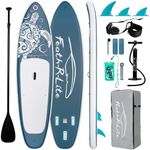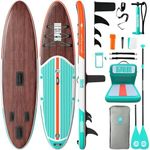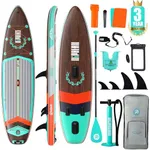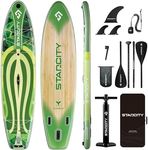Buying Guide for the Best Paddle Boards
Choosing the right paddle board can make a big difference in how much you enjoy your time on the water. The best paddle board for you depends on your experience level, where you plan to use it, and what kind of activities you want to do—like leisurely paddling, yoga, touring, or even surfing. Understanding the main features and how they relate to your needs will help you make a confident choice.Board TypePaddle boards come in several types, such as all-around, touring, yoga, and surf. This refers to the shape and design of the board, which affects how it performs. All-around boards are versatile and good for beginners or casual use. Touring boards are longer and designed for speed and distance, making them better for longer trips. Yoga boards are wider and more stable, ideal for fitness activities. Surf paddle boards are shorter and more maneuverable for riding waves. Think about what you want to do most often, and choose a board type that matches those activities.
LengthThe length of a paddle board affects its speed, stability, and maneuverability. Shorter boards (under 10 feet) are easier to turn and are good for surfing or kids. Medium boards (10 to 12 feet) are great for all-around use and beginners. Longer boards (over 12 feet) are faster and track straighter, making them ideal for touring or racing. If you’re new or want a board for general use, a medium length is usually a safe bet. If you have a specific activity in mind, like racing or yoga, pick a length that suits that purpose.
WidthWidth determines how stable a paddle board feels. Wider boards (over 32 inches) are more stable and better for beginners, yoga, or carrying extra gear. Narrower boards (under 30 inches) are faster and easier to paddle quickly, but they can feel less stable, especially for new users. If you value stability or plan to do activities like yoga, go for a wider board. If you want speed or have experience, a narrower board might suit you better.
ThicknessThickness affects both the board’s buoyancy and how much weight it can support. Thicker boards (around 6 inches) can hold more weight and are often more rigid, which is good for heavier paddlers or carrying gear. Thinner boards (4 to 5 inches) sit lower in the water and can feel more stable for lighter users, but may not support as much weight. Consider your body weight and whether you’ll carry extra items when choosing thickness.
Construction (Inflatable vs. Solid)Paddle boards are either inflatable or solid (hard). Inflatable boards are easy to transport and store, making them great for people with limited space or who travel often. They are also softer, which can be safer for beginners or kids. Solid boards offer better performance, speed, and a more direct feel on the water, but they require more storage space and are heavier to carry. Think about your storage, transportation needs, and how you plan to use the board when deciding between these two.
Weight CapacityWeight capacity tells you how much weight the board can safely support, including your body and any gear. If you exceed this limit, the board may sit too low in the water and become unstable. Always check the weight capacity and make sure it’s enough for you and anything you plan to bring along. If you’re close to the limit, it’s better to choose a board with a higher capacity for better performance and safety.
FinsFins help the board track straight and provide stability. Some boards have a single large fin, while others have three fins (a larger center fin and two smaller side fins). Removable fins offer flexibility for different water conditions. For flat water, a single large fin works well, while three fins can help with maneuverability in surf. Consider where you’ll use the board most often and choose a fin setup that matches those conditions.
